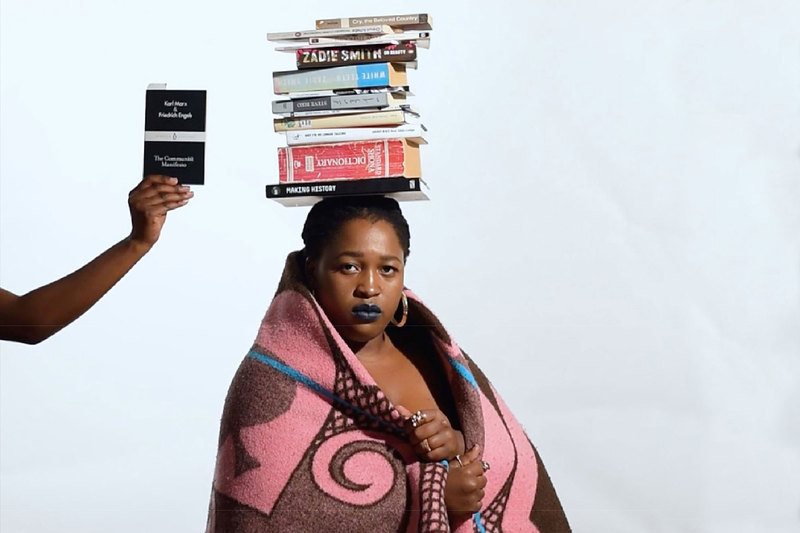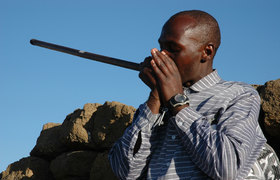UCT acquires work of art by Gerald Machona
13 September 2021 | Story Stephen Langtry. Photo Supplied. Read time 4 min.
Gerald Machona’s Survive, a video work partly inspired by the artist’s involvement in the student protests of 2015 and 2016.
Survive formed part of an exhibition at the Goodman Gallery from 4 October to 3 November 2018. Machona was born in Zimbabwe, and is a graduate of the Michaelis School of Fine Art at UCT. His work drew international attention while he was still a student, and he was actively involved with the Rhodes Must Fall (#RMF) and Fees Must Fall (#FMF) movements at UCT.
Survive raises questions about education, and alludes to the #RMF and #FMF movements of 2015 and 2016 and their calls for decolonisation. A decision has yet to be made on where to display Survive; it could form part of an exhibition, but it would also be available for consignment.
Machona met Tankiso Mamabolo, a UCT graduate, during the height of the #RMF protests. Following the removal of the statue of Cecil John Rhodes from UCT’s main campus, Mamabolo and seven other students wrote and performed The Fall, which documented their experiences of, among others, white supremacy, elitism and patriarchy.
Mamabolo is seen in Survive with books stacked atop her head. This, according Dr Fari Nzinga in the Works of Art Collection (WOAC) e-brochure on the acquisition, alludes to “teach-ins and political education projects that emerged alongside student protests and performances”.
“I compared the books of students who participated in the Fallist protests,” said Machona, also documented in the e-brochure.
“Books that they were reading at that moment or that they had written themselves. Tankiso then wrapped herself in her traditional Basotho blanket and we stacked all the books on her head while she sang a song about her experience with the academic world in the time of these protests”.
Mamabolo’s song “Shake the Ground”, which she wrote and performed, is also featured in Survive.
Historical collection
The acting chairperson of the WOAC committee, Dr Portia Malatjie, said Machona’s work is a pertinent addition to UCT’s collection because of its content, theme and symbolism.
Dr Malatjie is the deputy chairperson of the WOAC, and has taken on the role of acting chairperson while Associate Professor Nomusa Makhubu, the committee’s incumbent chairperson, is on sabbatical.
Malatjie joined UCT at the beginning of 2020. She is a curator and senior lecturer at UCT’s Michaelis School of Fine Art, and holds a PhD in Visual Cultures from Goldsmiths University of London. Malatjie previously lectured at Goldsmiths University of London and Rhodes University, and is currently adjunct curator at the Tate Modern in London and at the Norval Foundation in Cape Town.
Dr Malatjie said that though the WOAC has been around for a long time, its role has evolved more recently. The committee includes a curatorial team that guides the display of art.
Sometimes the WOAC receives requests from departments to remove an artwork which no longer speaks to the ethos of the institution. In those cases, the work will be replaced by another piece.
“There is a kind of a reparative and restorative impetus at this moment.”
The student protests of 2015 and 2016 “propelled and sparked new efforts to engage with what the collection was, and what the collection could be”, said Malatjie.
“The idea of transformation became quite pertinent to the way in which the collection operates.”
A lot of gaps were identified in the collection, including the under‑representation of artists of colour.
“There is a kind of a reparative and restorative impetus at this moment. It might not be the case in 10 years’ time,” said Malatjie.
“It is a historical collection; and like most historical things, you have the burden of a previous regime that essentially was collecting things according to their ideology at the time,” she added.
Transforming the collection
“Transforming the collection, and what the collection is, has been at the forefront of collecting and curating works of art at UCT. What can the collection do in fostering debate and artistic engagement?” said Malatjie.
One of the challenges of university collections is collecting without curatorship. This is something that the WOAC is trying to think about.
“If you were to have an exhibition from the works in the collection, are you able to have a running theme that goes beyond ‘these are the works that are in the collection’?”
Some of the future considerations in building the collection include looking beyond Cape Town and the rest of the country to see what’s happening on the rest of the continent. Malatjie added that while there is a focus on the collection (as in acquiring and broadening it), the collection – through public programming – should also be used to generate critical conversations.
*A decision has yet to be made on where to display Survive; it could form part of an exhibition, but it would also be available for consignment.
 This work is licensed under a Creative Commons Attribution-NoDerivatives 4.0 International License.
This work is licensed under a Creative Commons Attribution-NoDerivatives 4.0 International License.
Please view the republishing articles page for more information.










